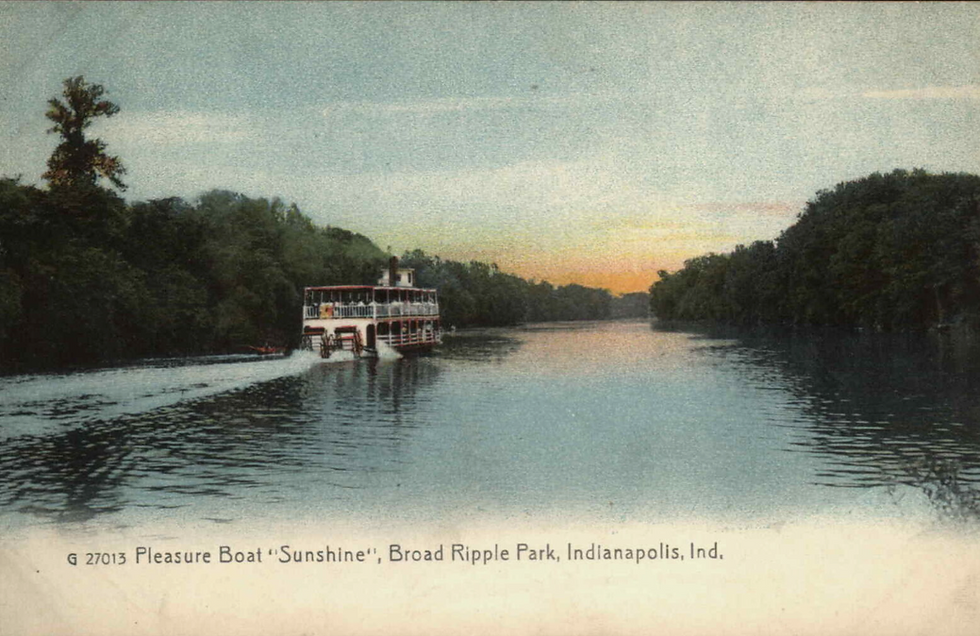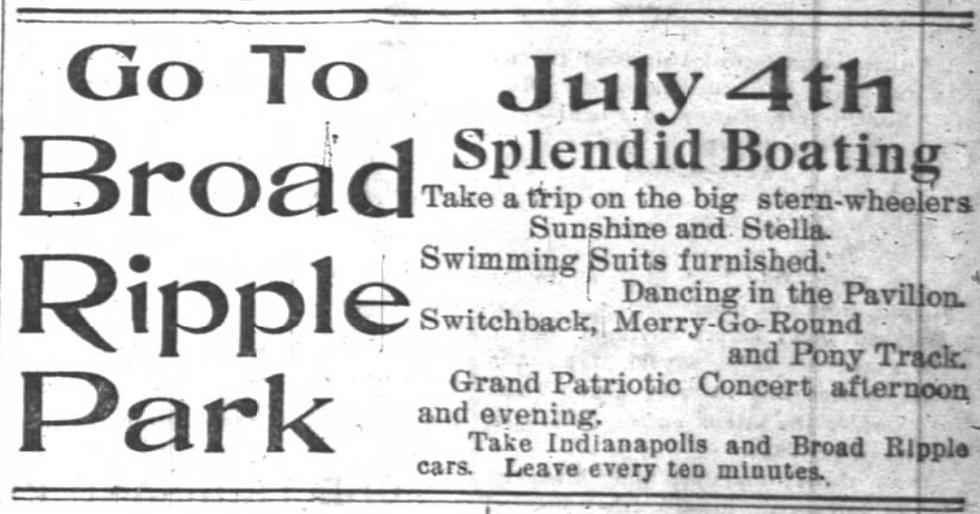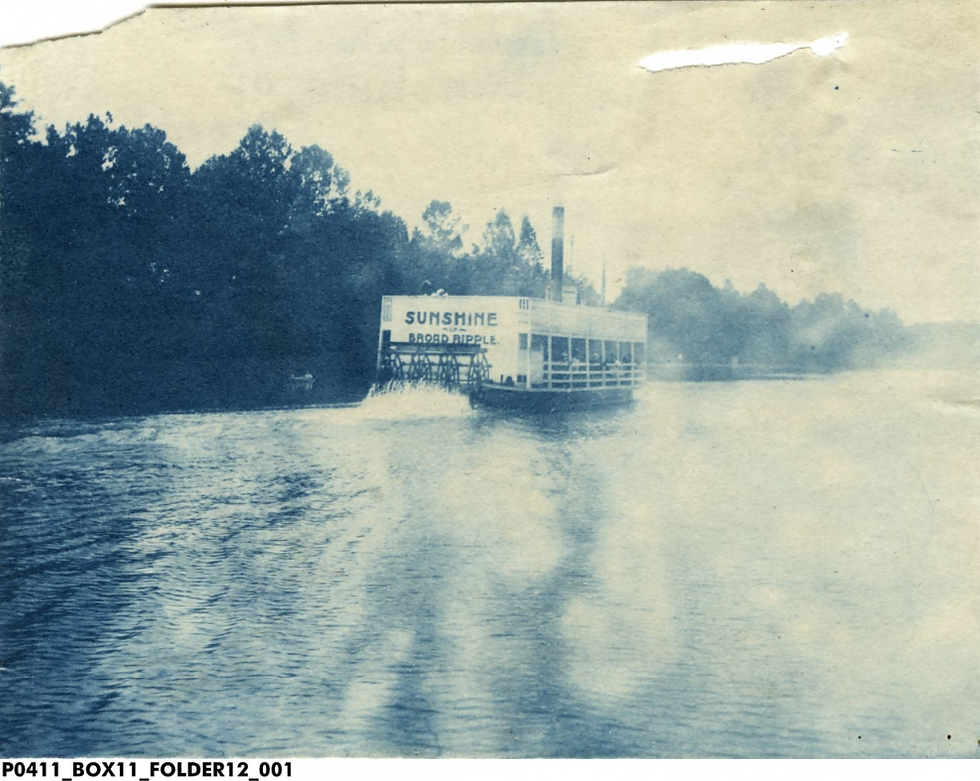Disaster at Broad Ripple: The Sinking of the Steamboat Sunshine
- Ed Fujawa
- May 8, 2024
- 11 min read

The history of waterways in and around Indianapolis is a common topic on this blog. A prior post (linked here) explored the navigability of the White River, and a few of the watercraft which once operated in Indianapolis, including the steamboat, Governor Morton.
Recently, I was researching a supplement to this previous post, focusing on some of the other watercraft which sailed around in other parts of the city. In the process of this research, I ran across a reference to the steamer “Sunshine,” which operated near Broad Ripple. The river north of the Broad Ripple dam has traditionally been a busy place for watercraft, with the pool created by the dam used for a variety of excursion boats, canoes, and rowboats. Many of these launched from the Broad Ripple Park area, while others from homes and clubs along the banks of the river further upstream from the park.
Broad Ripple is where the steamer Sunshine sailed from, with trips upstream to about where the Keystone bridge is today. Near that point were the remains of an old dam which made further travel upstream more difficult, so upon reaching this point, an about face was executed for a return trip downstream. The Sunshine was a paddle boat and had originally been brought to Indianapolis around 1896 or 1897, and had originally been constructed to operate on Winona Lake, near the towns of Warsaw and Winona Lake, Indiana. Reports from Winona Lake were that the boat, at the time named the “City of Warsaw,” was at first refused permission to carry passengers by local Winona Lake officials, although the exact reason was not identified. Mechanical issues hampered the craft before it was sold, cut in two, and transported to Indianapolis, where it was based at Broad Ripple Park.
The only possible image I found of the City of Warsaw is this postcard from the collections at Grace College. The image is dated 1916, which is based on the postmark on the postcard, although it could have been an older card used in 1916, or a second City of Warsaw which was constructed after the Sunshine departed, and which operated at Winona Lake for a number of years.

For the next several years the steamer operated as an excursion boat at Broad Ripple, carrying passengers up and down the river, while also being chartered for parties, picnics, and dances by local social groups, businesses, and families. The boat was not a substantial one, designed more for lake and slow river travel, and not for the rougher waters of the Wabash or Ohio Rivers. The boat had two decks topped with a pilothouse and, in the early years, a pair of smokestacks. The image below is undated, but I believe it was taken in 1897-1900. Note the two decks for passengers, and a roof covering the top deck. Staircases bow and aft can also be seen. Also note the size of the boat compared to the passengers on board evidencing its relatively small size.

The Sunshine did well on the White River because its bottom was flat, and its draft, or how low in the water it sat, was very shallow, around 16 inches. This allowed the Sunshine to overcome most debris or shallow areas along the river, although the boat mostly stayed in the main channel, which averaged several feet deep. The boat underwent several updates and refits while in Broad Ripple. In the winter and spring of 1903, the boat underwent a major refit. Its old powerplant was replaced with a lighter “electro vapor type” 30 horsepower engine. Since the new engine was lighter than its predecessor, the Sunshine’s draft became even shallower, at 9 inches. Additionally, the more efficient machinery allowed additional space for passengers, 1/3 more, and reduced the amount of smoke generated. Another major refit was completed in April of 1905. According to the Indianapolis News, the Sunshine was being rebuilt and enlarged and would be “practically a new boat from the water line up.” Its length after the refit would be 80 feet with an increased passenger capacity of 300.
While not dated, I suspect the image below shows the Sunshine after either the 1903 or 1905 refit, both of which seemed rather significant. As shown in the image, the boat now sports a single smokestack, a sign of a more efficient and compact powerplant. Additionally, the roof on the top deck has been removed. It's difficult to gauge the vessel's length, although I was unable to locate the length of the boat when it first arrived in Indianapolis. Note the name of the boat, “Sunshine of Broad Ripple,” has been painted on the rear bulkhead.

On Monday, August 7, 1905, the steamer Sunshine launched for what was yet another charted party cruise on its normal route, upstream to the turnaround point, and then back down to its launch at Broad Ripple Park. On board was a large group, reportedly nearly 170, of employees from the Union Stockyards in West Indianapolis. It was a day of celebration, preceded by a large picnic at a nearby hotel for the attendees. On board the steamer was a band, located on its top deck, which played popular tunes as the boat puttered along. As the Sunshine steamed southward on its return voyage towards its dock, disaster struck.
Allegedly, a young man and woman were paddling by in a canoe when the woman waved a handkerchief at the Sunshine to say hello (some reports say the wave was to acknowledge a patriotic song being played by the band). This simple action caused the passengers on Sunshine to rush to one side of the boat to see, as the Indianapolis Star described her, the “fair canoeist.” This caused the Sunshine to list dramatically to one side and it began to take on water over its deck. Worse, the motion caused a chain attached to a flywheel which helped drive the paddle to snap, leaving the boat without propulsion. A confusing situation ensued, and when a rescue launch arrived to help the stricken steamer, the passengers again crowded to one side to see what was happening, and again caused the Sunshine to list. More water was taken on and Sunshine began to founder.
Panic ensued as the boat became lower in the water, and then tipped to one side as it settled into the White River. The lower deck was reported to have buckled, causing the upper deck to collapse inward, and then over, as passengers fell into the river and struggled about. Numerous other watercraft came to the aide of the passengers in the water, who were taken back to shore at Broad Ripple Park. Early reports were that there were no deaths, although several individuals were missing, and it was assumed they had escaped and just not checked in before leaving the scene of the disaster.
Reporter Mark Thistlewaite, who had the first report from the scene for the Indianapolis Star the morning after the sinking, attributed the lack of deaths in the incident to the lack of women and children on board at the time. He explained that the men from the stockyards were “able bodied” and were “capable of caring for themselves under any and all circumstances.” Mr. Thistlewaite seemed to have forgotten that the men on board, according to his own reporting, apparently had caused the sinking by rushing to one side of the boat when presented with an attractive woman waiving a handkerchief.
As night fell, most of the Sunshine lay underwater, except for a part of its hull and portions of its superstructure (pilot house and the second story of the deck, as shown in the images below, both from the Indianapolis Star). Several individuals remained missing as well, while several others had sustained injuries, ranging from cuts and bruises to a crushed chest and broken legs. Unfortunately, not all of the missing would be found. Around 2:45 in the afternoon on August 8, the day after the sinking, the body of Lorah H. Whitson was found just a few feet north, or upstream, of the wreckage of the Sunshine. Recovery operations had been conducted all morning, with swimmers going into the water in attempts to find Whitson’s remains, while other dragged the river with grappling hooks.
Marion County Coroner Harry D. Tutewiler announced plans for a “thorough investigation of the disaster and would spare no efforts in his attempt to fix responsibility for the sinking of the vessel.” At the same time, government officials detailed their responsibilities towards the boat and its operations. Eugene L. Dorsey, a federal steamboat inspector for the area reported that Sunshine had not been inspected since it operated on a river which was not “navigable” under federal law. D.H. McAbee, the state’s factory inspector, reported that while the power plant for the steamer had been inspected, his authority did not extend to the seaworthiness of the steamer herself.
Whitson’s father had been on the scene of recovery efforts since the day before, along with one of Whitson’s brothers-in-law. His father was “prostrated with grief” when his son’s remains were brought back to the launch at Broad Ripple Park. Whitson was married with two young children, and his wife collapsed in despair and was placed under observation of a physician when she was informed of her husband's death. The brother-in-law told the Star that when he had taken a voyage on the Sunshine, three years before, he considered the boat as “unsafe.” Also on scene were representatives of the Union Traction Co., who were the owners of the Sunshine. While likely there due to concern about liability for their company, one of the representatives, J.F. Starkey, was asked whether a new boat would be built. He noted that the topic had not been discussed at the time.
Coroner Tutewiler’s investigation was launched, and the seaworthiness of the vessel was a familiar theme. While Tutewiler identified potential witnesses, opinions were tossed around in local newspapers about the cause of the disaster. J.T. Neville, a 20-year veteran of steamboats on the Mississippi who now lived at 906 Alabama Street, opined that the movement of the passengers from one side to another had likely caused the sinking. He explained that he had seen many vessels where the rapid movement of passengers from one side to another caused the boat to take on water, and then the shifting of passengers to another side would cause the water to also shift and threaten the boat with capsize.
An F.W. Samuels told Tutewiler that he had planned to go on the excursion on the Sunshine, but decided not to when he saw how many people were going to be going aboard and he thought the boat “looked too frail to carry such a heavy load.” The pilot of the Sunshine, A. Metsker, provided Tutewiler with additional details, including that 171 passengers had been onboard. He described the “handsome woman” who passed in the canoe, the passenger’s rush to the railings to see her, and he and the crew’s attempts to control the crowd and the boat’s tilting. He did say the boat, which had undergone repairs and rebuild earlier in the year, was in good condition, despite reports the hull was in poor condition and waterlogged. Two other witnesses also testified to the condition of the boat following the recent rebuilding and repairs, opining that it was in good shape. H.C. Crockett, the captain of the boat at the time of the sinking, testified that he had no experience with steamboats and had previously been a motorman on an interurban for the Union Traction line. He also told Tutewiler that the Sunshine had no life preservers on board and had in the past carried as many as 275 passengers. Notably, the Union Traction Company had a representative onsite at the coroner’s office during witness testimony.
Testimony continued on August 11, with the featured witness being John F. Striebeck, who had once captained the boat, and served in various other roles relating to its operation. He testified that the boat was 65 tons and had once had 425 passengers on board. He said he had never had any issues with the boat, although he did recall one occasion during a rescue of YMCA campers from an island in the river during a sudden high-water event. As the boat was nearing the dock, the rescued campers rushed to its front, which caused the rear of the boat, where the paddle was, to lift out of the water, depriving the Sunshine of power, and causing the boat to crash into the dock.
Striebeck also said that when he heard the distress signal from his office at the dock, he had taken a rowboat out to the Sunshine to see what was happening. Per his testimony to the coroner, Striebeck was alarmed by the shifting passengers from one side to another. He cried out “[f]or God’s sake go back to the center of the boat and stay there!” In response, a passenger yelled back “Who in the hell are you?”

Other witnesses provided contrary reports regarding the rushing of passengers to one side and the other. One said he thought the boat was taking on water from the start of the excursion and that the boat settled more or less straight into the water, without the tipping others had reported. Others faulted the crew for their actions in response to the disaster, with some claiming that the captain was the first off the boat when the crew abandoned the vessel.
Finally, on Friday, August 25, 1905, the results of the investigation were announced. Unfortunately, Coroner Tutewiler was stricken with a sudden illness on or about August 15, and one of his deputies, Deputy Coroner Robertson, took over the investigation. Robertson issued the coroner’s office’s determination, finding first that Lorah Whitson died of drowning while trying to escape the Sunshine, versus blunt force injury from the collapsing super structure. The report noted that the Sunshine was “substantially built,” and its wooden structure in “good condition,” although the hull above the waterline needed caulking. Robertson further reported that while the boat was not overloaded, the weight was not distributed properly: “I believe the weight was injudiciously placed, two-thirds of the weight being on the upper deck, raising the center of gravity too high.” Such a condition made the boat more susceptible to tipping. He also noted that there had been water in the hull, which contributed to the imbalance, and it did not take much shifting of weight from one side or another to cause the side of the boat to drop below the waterline.
But in a surprising turn, the coroner’s report did not place the blame on the crew, or the Union Traction Company. Instead, it blamed the federal government. In what may have been the coroner’s office seeking to avoid placing blame on a powerful local company, the report noted that the Sunshine operated under a license from the federal government but had never been inspected by that authority since it did not operate on a section of the river considered “navigable.” The News described this as the "most startling feature of the Sunshine wreck." Robertson declared that "[a] government license is a guarantee of safety to most people, and we have in this State on our numerous inland lakes hundreds of boats, carrying precious human freight, that have never been inspected by any one in authority."
However, the coroner’s throwing of the Federal government under the bus did not insulate the Union Traction Terminal Company from legal action. On December 13, 1905, the estate of Lorah Whitson filed suit against the company alleging that the boat was in poor condition, with decaying timbers, an old powerplant, and insufficient structural support for the boat’s second level. The estate sought $10,000 in compensation. In April of 1907 the lawsuit was resolved following a trial by jury in Noblesville (unclear why venue was in Hamilton County). The jury returned a verdict in favor of the estate for $5,000, roughly $175,000 today.

Boating continued to be a popular activity on the White River in Broad Ripple following the loss of the Sunshine. A replacement steamboat, the appropriately named “Sunbeam,” was constructed a few years later and continued to ply the water upstream from the Broad Ripple dam until it was destroyed by ice in the 1920s. The Sunshine is remembered as a component of an illustrated map of the White River published by the Friends of the White River advocacy group, as shown above, and purchased by a local collector from a recent estate auction. The Sunshine is depicted incorrectly, and the dates of operation are quite wrong (not sure where the 1807 came from) although if you look closely, you can see passengers crowded to one side of the boat and the vessel leaning precariously as a result.
Sources
Indianapolis News: July 2, 1898, April 4, 1903, April 26, 1905, August 8, 1905, August 11, 1905, August 25, 1905, July 17, 1937
Indianapolis Star: August 8-13, 1905, August 16, 1905, December 14, 1905, April 19, 1907
Indianapolis Journal: August 7, 1897
Steamboat "Sunshine" at Broad Ripple Park, General photograph collection, Rare Books and Manuscripts, Indiana State Library, https://indianamemory.contentdm.oclc.org/digital/collection/p16066coll13/id/2872
Sunshine of Broad Ripple, Indiana Historical Society General Picture Collection, https://images.indianahistory.org/digital/collection/p16797coll28/id/296/rec/1
1902, Journal Handbook of Indianapolis: An Outline History, https://iuidigital.contentdm.oclc.org/digital/collection/IndyHist/id/737/rec/4






Comments